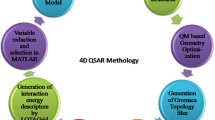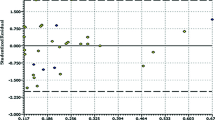Abstract
A three-dimensional quantitative structure activity relationship (3D-QSAR) study was carried out on a dataset of 62 cinnamoyl derivatives as human immunodeficiency virus-1 integrase (HIV-1 IN) inhibitors using k-nearest neighbor molecular field analysis (kNN-MFA). QSAR models were developed using stepwise-forward selection (SWF), genetic algorithm (GA), and simulated annealing (SA) variable selection approaches. Selected QSAR models were validated internally [using cross-validated squared correlation coefficient (q 2)] and externally [using predicted squared correlation coefficient (pred_r 2) and Y randomization] to determine their predictive ability. SA-kNN-MFA model (q 2 = 0.7669, pred_r 2 = 0.7566) was considered as the best model due to its better predictive ability (higher pred_r 2 value) as compared to SWF-kNN-MFA (q 2 = 0.8956, pred_r 2 = 0.5905) and GA-kNN-MFA (q 2 = 0.6431, pred_r 2 = 0.7525) models in external validation. Steric and electrostatic field descriptors were favorable for HIV-1 IN inhibition activity in the best model. HIV-1 IN inhibition activity of an external dataset containing 22 compounds was predicted to check the applicability domain of developed models. Drug-likeness and in silico absorption, distribution, metabolism, excretion, and toxicity (ADME/T) studies were also performed to determine the pharmacokinetic and toxicity profile of dataset compounds. Subsequently, HIV-1 IN inhibition activity of 53 proposed compounds was predicted using developed models and their ADME/T properties were also calculated. Results of the present study suggested that 3D-QSAR model developed by SA-kNN-MFA method may be helpful to understand the structural requirement for HIV-1 IN inhibition and may support the designing of potent antiretroviral agents.







Similar content being viewed by others
References
Ajmani S, Jadhav K, Kulkarni SA (2006) Three-dimensional QSAR using the k-nearest neighbor method and its interpretation. J Chem Inf Model 46(1):24–31. doi:10.1021/ci0501286
Artico M, Di Santo R, Costi R, Novellino E, Greco G, Massa S, Tramontano E, Marongiu ME, De Montis A, La Colla P (1998) Geometrically and conformationally restrained cinnamoyl compounds as inhibitors of HIV-1 integrase: synthesis, biological evaluation, and molecular modeling. J Med Chem 41(21):3948–3960. doi:10.1021/jm9707232
Buolamwini JK, Assefa H (2002) CoMFA and CoMSIA 3D QSAR and docking studies on conformationally-restrained cinnamoyl HIV-1 integrase inhibitors: exploration of a binding mode at the active site. J Med Chem 45(4):841–852. doi:10.1021/jm010399h
Burke TR Jr, Fesen M, Mazumder A, Yung J, Wang J, Carothers AM, Grunberger D, Driscoll J, Pommier Y, Kohn K (1995) Hydroxylated aromatic inhibitors of HIV-1 integrase. J Med Chem 38(21):4171–4178. doi:10.1021/jm00021a006
Costi R, Santo RD, Artico M, Massa S, Ragno R, Loddo R, La Colla M, Tramontano E, La Colla P, Pani A (2004) 2,6-bis(3,4,5-trihydroxybenzylydene) derivatives of cyclohexanone: novel potent HIV-1 integrase inhibitors that prevent HIV-1 multiplication in cell-based assays. Bioorg Med Chem 12(1):199–215. doi:10.1016/j.bmc.2003.10.005
Cramer RD, Patterson DE, Bunce JD (1988) Comparative molecular field analysis (CoMFA). 1. Effect of shape on binding of steroids to carrier proteins. J Am Chem Soc 110(18):5959–5967. doi:10.1021/ja00226a005
Demeulemeester J, Christ F, De Maeyer M, Debyser Z (2012) Fueling HIV-1 integrase drug design with structural insights. Drug Discov Today Technol 9(3):e205–e212. doi:10.1016/j.ddtec.2012.05.005
Eich E, Pertz H, Kaloga M, Schulz J, Fesen MR, Mazumder A, Pommier Y (1996) (−)-Arctigenin as a lead structure for inhibitors of human immunodeficiency virus type-1 integrase. J Med Chem 39(1):86–95. doi:10.1021/jm950387u
Erickson JW, Burt SK (1996) Structural mechanisms of HIV drug resistance. Annu Rev Pharmacol Toxicol 36(1):545–571. doi:10.1146/annurev.pa.36.040196.002553
Ertl P, Rohde B, Selzer P (2000) Fast calculation of molecular polar surface area as a sum of fragment-based contributions and its application to the prediction of drug transport properties. J Med Chem 43(20):3714–3717. doi:10.1021/jm000942e
Esposito E, Hopfinger A, Madura J (2004) Methods for applying the quantitative structure–activity relationship paradigm. In: Bajorath J (ed) Chemoinformatics. Methods in Molecular Biology™, vol 275. Humana Press, Clifton, NJ, pp 131–213. doi:10.1385/1-59259-802-1:131
Fesen MR, Pommier Y, Leteurtre F, Hiroguchi S, Yung J, Kohn KW (1994) Inhibition of HIV-1 integrase by flavones, caffeic acid phenethyl ester (CAPE) and related compounds. Biochem Pharmacol 48(3):595–608. doi:10.1016/0006-2952(94)90291-7
Gasteiger J, Marsili M (1980) Iterative partial equalization of orbital electronegativity: a rapid access to atomic charges. Tetrahedron 36(22):3219–3228. doi:10.1016/0040-4020(80)80168-2
Ghose AK, Viswanadhan VN, Wendoloski JJ (1998) A knowledge-based approach in designing combinatorial or medicinal chemistry libraries for drug discovery. 1. A qualitative and quantitative characterization of known drug databases. J Comb Chem 1(1):55–68. doi:10.1021/cc9800071
Golbraikh A, Tropsha A (2002a) Beware of q 2. J Mol Graph Model 20(4):269–276. doi:10.1016/S1093-3263(01)00123-1
Golbraikh A, Tropsha A (2002b) Predictive QSAR modeling based on diversity sampling of experimental datasets for the training and test set selection. J Comput Aided Mol Des 16(5):357–369. doi:10.1023/a:1020869118689
Gupta P, Garg P, Roy N (2013) In silico screening for identification of novel HIV-1 integrase inhibitors using QSAR and docking methodologies. Med Chem Res:1–15. Doi:10.1007/s00044-013-04
Jain S, Ghate M, Bhadoriya K, Bari S, Chaudhari A, Borse J (2012) 2D, 3D-QSAR and docking studies of 1,2,3-thiadiazole thioacetanilides analogues as potent HIV-1 non-nucleoside reverse transcriptase inhibitors. Org Med Chem Lett 2(1):22
Jorgensen WL, Duffy EM (2002) Prediction of drug solubility from structure. Adv Drug Deliv Rev 54(3):355–366. doi:10.1016/S0169-409X(02)00008-X
Kirkpatrick S, Gelatt CD, Vecchi MP (1983) Optimization by simulated annealing. Science 220(4598):671–680. doi:10.1126/science.220.4598.671
Klebe G, Abraham U, Mietzner T (1994) Molecular similarity indices in a comparative analysis (CoMSIA) of drug molecules to correlate and predict their biological activity. J Med Chem 37(24):4130–4146. doi:10.1021/jm00050a010
LaFemina RL, Graham PL, LeGrow K, Hastings JC, Wolfe A, Young SD, Emini EA, Hazuda DJ (1995) Inhibition of human immunodeficiency virus integrase by bis-catechols. Antimicrob Agents Chemother 39(2):320–324. doi:10.1128/aac.39.2.320
Lipinski CA, Lombardo F, Dominy BW, Feeney PJ (2001) Experimental and computational approaches to estimate solubility and permeability in drug discovery and development settings. Adv Drug Deliv Rev 46(1–3):3–26. doi:10.1016/S0169-409X(00)00129-0
Mazumder A, Gazit A, Levitzki A, Nicklaus M, Yung J, Kohlhagen G, Pommier Y (1995a) Effects of tyrphostins, protein kinase inhibitors, on human immunodeficiency virus type 1 integrase. Biochemistry 34(46):15111–15122. doi:10.1021/bi00046a018
Mazumder A, Raghavan K, Weinstein J, Kohn KW, Pommier Y (1995b) Inhibition of human immunodeficiency virus type-1 integrase by curcumin. Biochem Pharmacol 49(8):1165–1170. doi:10.1016/0006-2952(95)98514-A
Mercader AG, Duchowicz PR, Fernández FM, Castro EA (2010) Replacement method and enhanced replacement method versus the genetic algorithm approach for the selection of molecular descriptors in QSPR/QSAR theories. J Chem Inf Model 50(9):1542–1548. doi:10.1021/ci100103r
Michalewicz Z (1996) Genetic algorithms. In: Genetic algorithms + data structures = evolution programs. Springer, Berlin. pp 11–93. doi:10.1007/978-3-662-03315-9_2
Neumann PJ, Weinstein MC (2010) Legislating against use of cost-effectiveness information. N Engl J Med 363(16):1495–1497. doi:10.1056/NEJMp1007168
Ntie-Kang F (2013) An in silico evaluation of the ADMET profile of the StreptomeDB database. SpringerPlus 2(1):353
Parrill AL (2008) Introduction to evolutionary algorithms. In: Evolutionary algorithms in molecular design. Wiley, Hoboken, NJ, pp 1–13. doi:10.1002/9783527613168.ch1
Rhodes DI, Peat TS, Van de Graaf N, Jeevarajah D, Le G, Jones ED, Smith J, Coates JAV, Winfield LJ, Thienthong N, Newman J, Lucent D, Ryan JH, Savage GP, Francis CL, Deadman JJ (2011) Structural basis for a new mechanism of inhibition of HIV integrase identified by fragment screening and structure based design. Antivir Chem Chemother 21:155–168. doi:10.3851/IMP1716
Robinson WE, Reinecke MG, Abdel-Malek S, Jia Q, Chow SA (1996) Inhibitors of HIV-1 replication that inhibit HIV integrase. Proc Natl Acad Sci 93(13):6326–6331
Sander T (2001) OSIRIS property explorer. http://www.organic-chemistry.org/prog/peo/drugScore.html. Accessed 31 Jan 2014
Sander T, Freyss J, von Korff M, Reich JRe, Rufener C (2009) OSIRIS, an entirely in-house developed drug discovery informatics system. J Chem Inf Model 49(2):232–246. doi:10.1021/ci800305f
Schrodinger-Suite (2010). QikProp, Version 33, Schrodinger, LLC, New York
Sepkowitz KA (2001) AIDS-the first 20 years. N Engl J Med 344(23):1764–1772. doi:10.1056/NEJM200106073442306
Sharma H, Patil S, Sanchez TW, Neamati N, Schinazi RF, Buolamwini JK (2011) Synthesis, biological evaluation and 3D-QSAR studies of 3-keto salicylic acid chalcones and related amides as novel HIV-1 integrase inhibitors. Bioorg Med Chem 19(6):2030–2045. doi:10.1016/j.bmc.2011.01.047
Sharma H, Cheng X, Buolamwini JK (2012) Homology model-guided 3D-QSAR studies of HIV-1 integrase inhibitors. J Chem Inf Model 52(2):515–544. doi:10.1021/ci200485a
Srivastav VK, Tiwari M (2013) QSAR and docking studies of coumarin derivatives as potent HIV-1 integrase inhibitors. Arab J Chem. doi:10.1016/j.arabjc.2013.01.015
Tropsha A, Gramatica P, Gombar VK (2003) The importance of being earnest: validation is the absolute essential for successful application and interpretation of QSPR models. Mol Inform 22(1):69–77. doi:10.1002/qsar.200390007
UNAIDS (2013) Global report: UNAIDS report on the global AIDS epidemic 2013
Veber DF, Johnson SR, Cheng H-Y, Smith BR, Ward KW, Kopple KD (2002) Molecular properties that influence the oral bioavailability of drug candidates. J Med Chem 45(12):2615–2623. doi:10.1021/jm020017n
Vengurlekar S, Sharma R, Trivedi P (2010) Two- and three-dimensional QSAR studies on benzyl amide-ketoacid inhibitors of HIV integrase and their reduced analogues. Med Chem Res 19(9):1106–1120. doi:10.1007/s00044-009-9256-y
Wold S, Eriksson L, Clementi S (2008) Statistical validation of QSAR results. In: Chemometric methods in molecular design. Wiley, Hoboken, NJ, pp 309–338. doi:10.1002/9783527615452.ch5
Zhang X, Neamati N, Lee YK, Orr A, Brown RD, Whitaker N, Pommier Y, Burke TR Jr (2001) Arylisothiocyanate-containing esters of caffeic acid designed as affinity ligands for HIV-1 integrase. Bioorg Med Chem 9(7):1649–1657. doi:10.1016/S0968-0896(01)00075-X
Zheng W, Tropsha A (2000) Novel variable selection quantitative structure–property relationship approach based on the k-nearest-neighbor principle. J Chem Inf Comput Sci 40(1):185–194. doi:10.1021/ci980033m
Acknowledgments
Authors are thankful to Director, SGSITS for providing state of art facilities to carry out research, University Grant Commission, New Delhi, for providing financial support, V-life Science Technologies Pvt. Ltd for providing software for the study and referees of this manuscript for their thoughtful comments that further improved the quality of manuscript.
Author information
Authors and Affiliations
Corresponding author
Electronic supplementary material
Below is the link to the electronic supplementary material.
Rights and permissions
About this article
Cite this article
Srivastav, V.K., Tiwari, M. k-nearest neighbor molecular field analysis based 3D-QSAR and in silico ADME/T studies of cinnamoyl derivatives as HIV-1 integrase inhibitors. Med Chem Res 24, 684–700 (2015). https://doi.org/10.1007/s00044-014-1183-x
Received:
Accepted:
Published:
Issue Date:
DOI: https://doi.org/10.1007/s00044-014-1183-x




